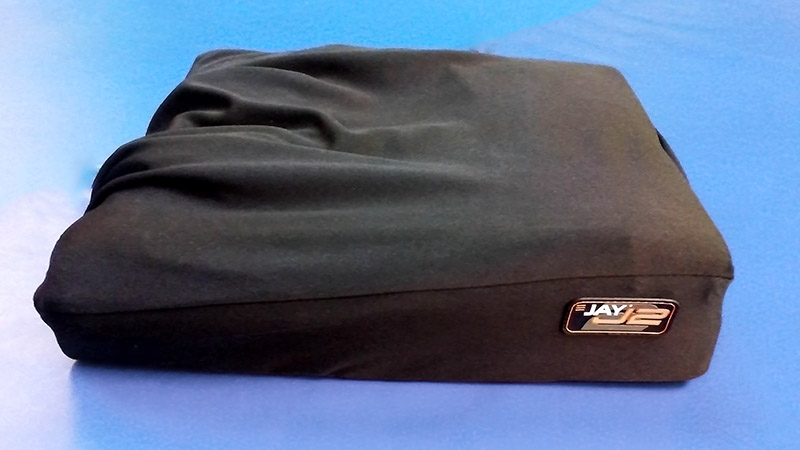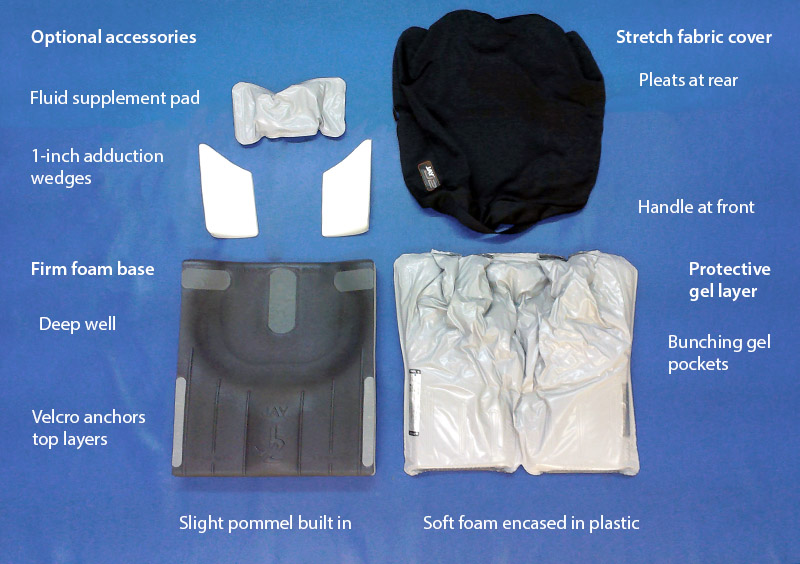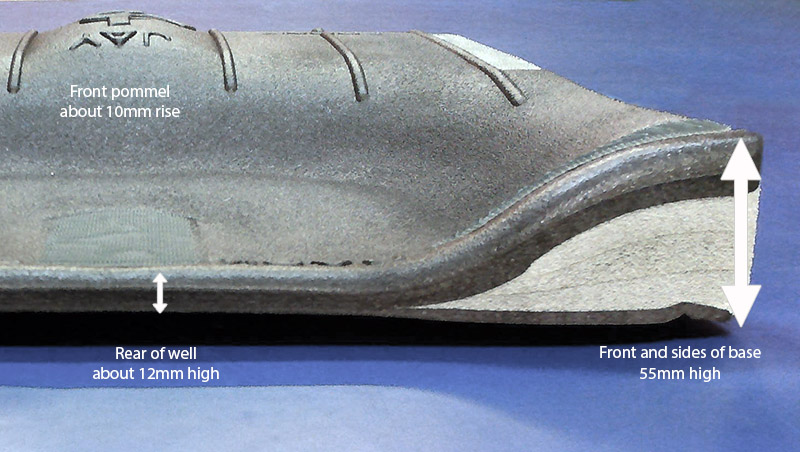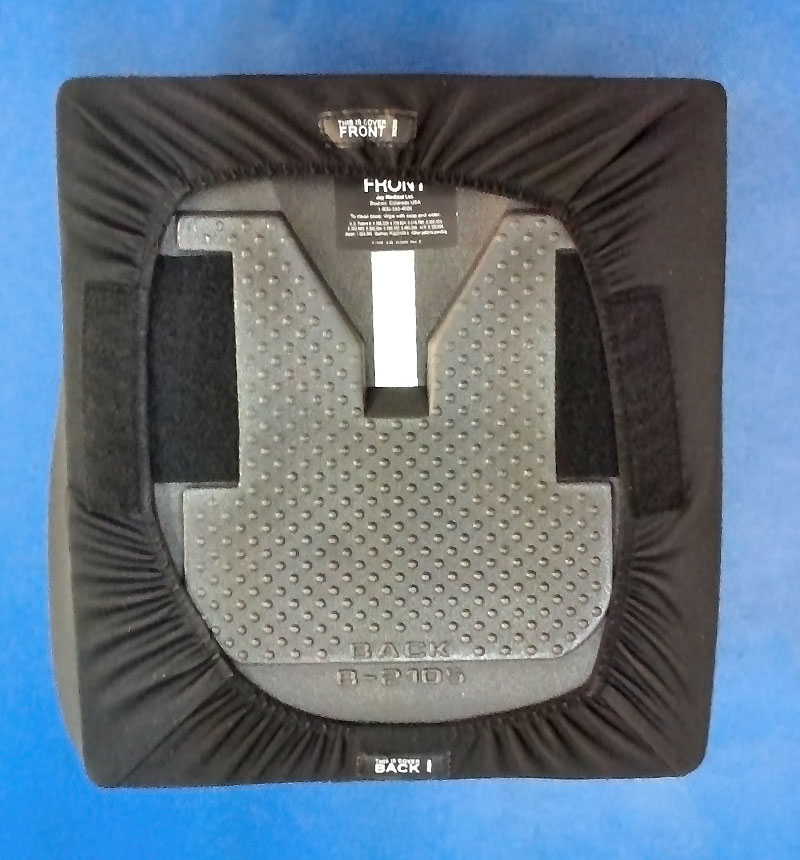Jay J2 Cushion Review
The Jay cushion range, available from Sunrise Medical, is a tried and true pillar of the wheelchair cushion world. While the J2 isn't suitable for every application, it allows easy customisation with modular components, and the design works well for users of many shapes, sizes, and postures.
The J2 range is quite comprehensive. The cushion shown is the standard J2. The J2 Deep Contour is another variant, which I have found to be a great cushion if more immersion is required, such as when the ischial tuberosities are particularly prominent. The J2 is available in:
Widths: 14-24 inches (36-61cm)
Depths: 14-20 inches (36-51cm)
Height: 2.5 inches (6.5cm)

J2 cushion side view, 16 inches (406mm) deep by 14 inches (355mm) wide
The widths and depths are customisable too. For example, I have ordered an 18-inch width where the well size was the same as the 15.5-inch cushion. The supplier added a 1-inch strip of foam to each side at no extra cost. I also love that if you (the OT or PT) are doing your own customisations on the foam base and it all goes horribly pear-shaped, Sunrise will replace it free of charge.

What's in the Box: Base, fluid tripad, and cover are essential components. The fluid supplement pad and adductor wedges are examples of the many modular components available to assist with postural management.
When opening up a J2 cushion box, you will find the cushion (firm foam base, fluid pad and cover), plus any accessories ordered. Accessories such as the adductor wedges or obliquity wedges come in pairs. The fluid supplement pads can be ordered individually and placed anywhere you like. I have found that you need to BYO additional adhesive Velcro and some scissors when setting up a J2 with additional postural components.
As there can be a bit of a delay between trialling the cushion with a user and their own cushion actually arriving, I've found that taking before and after photos of the user's posture, and taking photos of the set-up of the cushion at the stage where everyone was happy, is a great habit. When it comes time to configure cushion, I've got a reminder of what went where!

The base has a large, deep well at the rear, allowing the user's bony prominences (ischial tuberosities, sacrum and coccyx) to sink into the fluid. The lack of a firm back wall on the base removes all rub points for the sacrum.
The base is very firm foam; it has about as much give as polystyrene, but is much more durable. Some people wonder at how this firm foam can give such great pressure redistribution. The answer is the smart design. The contouring of the well, its shape and size, takes pressure off the ischial tuberosities (ITs) and tailbone, and shifts the weight-bearing to the greater trochanters (GTs) and the femurs.
The GTs and the femurs are protected by the layer of softer foam built into the fluid tripad. The ITs and tailbone are immersed in a fluid gel. The "tripad" is named such because it has three compartments (one for each risk area), which helps to stop the fluid migrating. That said, the fluid can still move about a fair bit. Whenever I prescribe this cushion, I am sure to tell the users that they need to check the fluid every day and push it back towards the middle.
The firm base at the front of the cushion is often appreciated by wheelchair users who side-transfer, because they can wriggle their bottom forward and sit well-supported on the front before moving themselves sideways onto the other seat.
The fluid tripad is itself customisable. It can be ordered with a specified percentage overfill, or underfill, and this can be specified for each compartment. For example, you could ask for 20% overfill all round for a user with a very bony bottom, or 10% overfill on one side to help correct a subtle pelvic obliquity. If a lot more gel is needed, you can call in the fluid supplement pad. I just love how easy this cushion is to configure in a million different ways.

The standard stretch cover is quick and easy to put on and remove. It is elasticated like a fitted bedsheet. Velcro on the underside of the base and cover stops the cushion sliding on the wheelchair seat.
The cushion cover is nice and simple. The stretchy, soft fabric seems to deal very well with sweat in our warm sub-tropical climate.
The potential downsides to be aware of:
- It's pretty heavy, weighing 3-5kg. Not the heaviest around, but I wouldn't call it a light-weight cushion
- The fluid pad occasionally bursts, so it loses some points on durability
- It requires daily maintenance (pushing the fluid back to the centre of the well)
- Need to keep an eye on potential pressure areas under GTs
- It doesn't come in paediatric sizes
The main benefits:
- It has a great design for pressure management of ITs and sacrum/coccyx
- It is easy to customise to accommodate or correct sitting posture, including pelvic obliquity, tilt and rotation
- It comes in a wide variety of sizes and configurations for adults and teens
- It is fairly easy to clean and maintain
How have you used the J2 cushion? Do you have any tips or stories to share? Leave a comment…